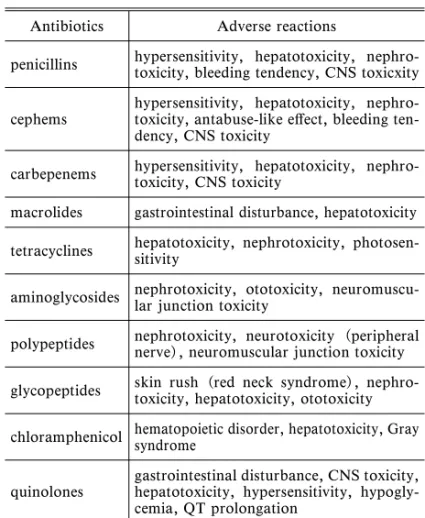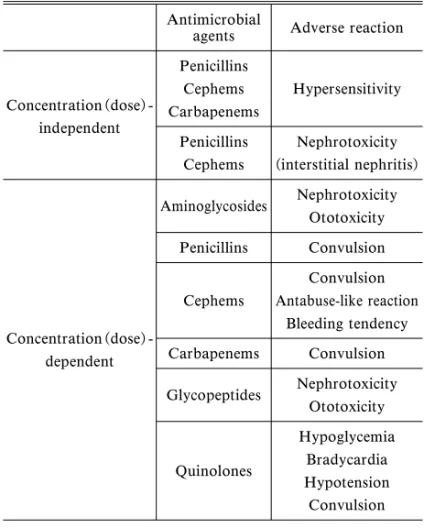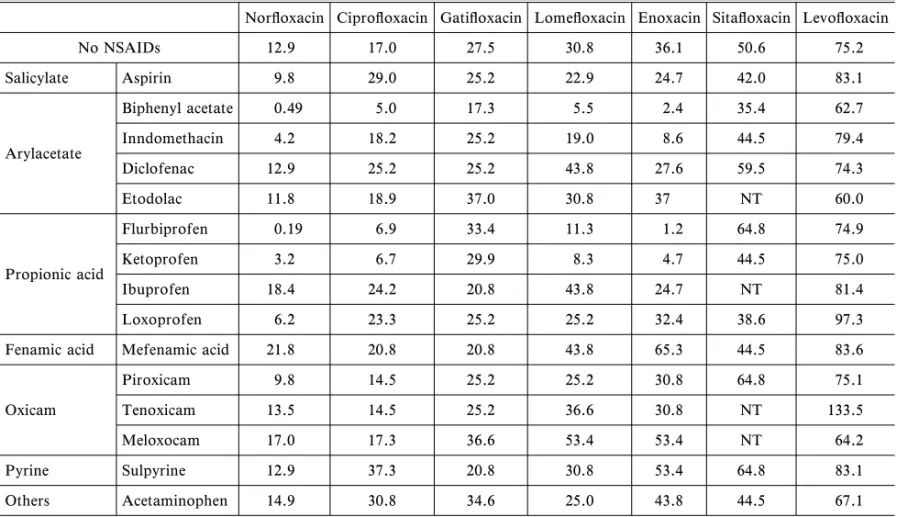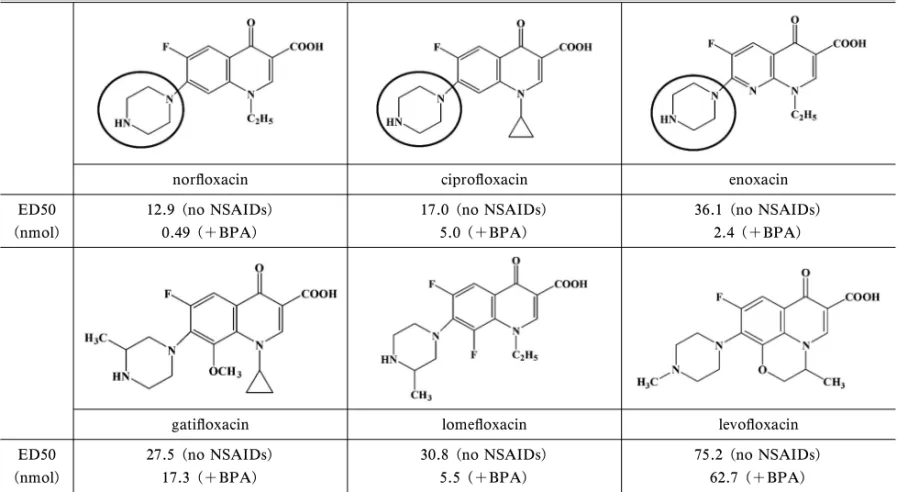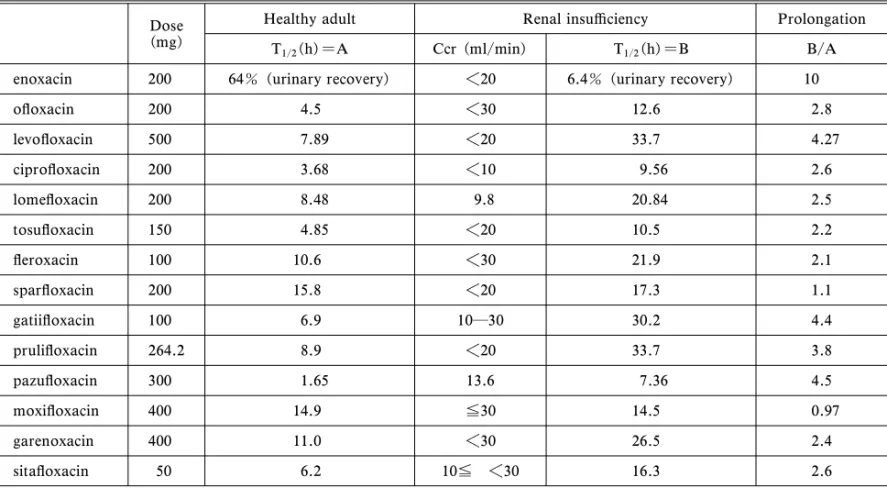東京慈恵会医科大学薬理学講座(〒1058461 東京都港 区西新橋 3258) 現所属:同感染制御部 e-mail: horis@jikei.ac.jp 本総説は,日本薬学会第 130 年会シンポジウム S01 で 発表したものを中心に記述したものである.
Table 1. Adverse Reaction of Antimicrobial Agents Antibiotics Adverse reactions
penicillins hypersensitivity, hepatotoxicity, nephro-toxicity, bleeding tendency, CNS toxicxity
cephems hypersensitivity, hepatotoxicity, nephro-toxicity, antabuse-like eŠect, bleeding ten-dency, CNS toxicity
carbepenems hypersensitivity, hepatotoxicity, nephro-toxicity, CNS toxicity macrolides gastrointestinal disturbance, hepatotoxicity tetracyclines hepatotoxicity, nephrotoxicity, photosen-sitivity aminoglycosides nephrotoxicity, ototoxicity, neuromuscu-lar junction toxicity polypeptides nephrotoxicity, neurotoxicity (peripheralnerve), neuromuscular junction toxicity glycopeptides skin rush (red neck syndrome), nephro-toxicity, hepatotoxicity, ototoxicity chloramphenicol hematopoietic disorder, hepatotoxicity, Graysyndrome
quinolones gastrointestinal disturbance, CNS toxicity,hepatotoxicity, hypersensitivity, hypogly-cemia, QT prolongation
―Review―
安全性から見た抗菌薬
堀
誠 治
Safety Proˆle of Antimicrobial Agents
Seiji H
ORIDepartment of Pharmacology, Jikei University School of Medicine, 3258 Nishi-Shimbashi, Minato-ku, Tokyo 1058461, Japan
(Received July 5, 2011)
Many antibiotics have been developed and used for the treatment of infectious diseases. Although they have been known to have various adverse eŠects, most of the mechanisms remain still unknown. New quinolones are well known to induce convulsions and their convulsant activity enhanced by concurrent administration of anti-in‰ammatory drugs. Each new quinolone has an individual convulsant activity with individual drug-interaction with anti-in‰ammatory drugs. And enoxacin, lome‰oxacin and gati‰oxacin have been reported to decrease blood glucose levels in a dose-depend-ent manner, but cipro‰oxacin and levo‰oxacin had no eŠect on the levels. It should be important to know the safety pro-ˆle of antimicrobial agents before doctors administer these agents to the patients with infectious diseases.
Key words―safety proˆle; antimicrobial agent; adverse eŠect
今日,多くの抗菌薬が,感染症治療に用いられて
いるが,それらは種々の副作用を有している.抗菌
薬の選択・投与法の設定においては,個々の抗菌薬
の beneˆt と risk(光と影)を理解しておく必要が
ある.ここでは,抗菌薬の安全性からみた個別化
(個々の薬剤における光と影)を検討したい.
1.
抗菌薬の主な副作用
抗菌薬には,Table 1 に示すような副作用のある
ことが知られている.その副作用を発現様式からみ
ると,投与量(濃度)依存的なものと,投与量(濃
度)によらない(非依存的)なものとに大別するこ
とができよう.抗菌薬副作用の発現様式・機序に関
して,多くは知られていない.副作用のうち,現在
その発現様式の知られている主なものは,Table 2
のようになろう.
1,2)抗菌薬副作用の発現様式を知ることは,PK-PD
の考えに基づき高投与量・高暴露となる抗菌薬投与
設定が行われている今日,副作用防止の観点から重
要な事項となる.投与量(濃度)非依存的な副作用
はアレルギー反応に基づくと考えられ,この副作用
発現の防止には,被疑薬を避けることが重要であ
Table 2. Mode of Adverse Reactions of Antimicrobial Agents
Antimicrobial
agents Adverse reaction
Concentration(dose)-independent Penicillins Cephems Carbapenems Hypersensitivity Penicillins Cephems Nephrotoxicity (interstitial nephritis) Concentration(dose)-dependent Aminoglycosides Nephrotoxicity Ototoxicity Penicillins Convulsion Cephems Convulsion Antabuse-like reaction Bleeding tendency Carbapenems Convulsion Glycopeptides Nephrotoxicity Ototoxicity Quinolones Hypoglycemia Bradycardia Hypotension Convulsion
Table 3. Number of Reported Cases with Allergic Reactions against Antimicrobial Agents
April 2008 September 2008 October 2008 February 2009 Penicillins 53 38 Cephems 123 112 Carbapenems 14 10 Glycopeptides 11 13 Macrorides 11 11 Tetracyclines 11 11 Aminoglycosides 0 2 New Quiinolones 92 103
Reference JJA 2009; 62: 2752 JJA 2009; 62: 371394
Allergic reactions: anaphylaxis, anaphylaxy shock, shock, drug erup-tion, urticaria, eruperup-tion, larynx edema.
る.そのためには,詳細な薬歴の聴取が必要とな
る.一方,投与量(濃度)依存的副作用の発現を抑
制するには,体内蓄積(血中濃度上昇)をきたさな
いように用法・用量の設定をすることが重要であ
る.抗菌薬の多くが腎から体外へ排泄されるので,
特に,腎障害のある患者に抗菌薬を投与する際には
注意を要する.
2.
抗菌薬副作用・薬物相互作用の個別化
抗菌薬の副作用は,多くの場合,その系統別にま
とめられている.そのことは,抗菌薬の安全性を理
解する上で重要である.しかし,最近になり,抗菌
薬の副作用・薬物相互作用の強さには,抗菌薬によ
り,また,薬物の組み合わせにより違いのあること
が明らかとなってきた.ここでは,ニューキノロン
薬(NQ 薬)を中心に,抗菌薬の安全性とその個別
化について考え直してみたい.
2-1.
NQ 薬による過敏反応
抗菌薬投与に伴
う過敏反応のあることは,よく知られている.その
頻度はペニシリン系・セフェム系薬で高いと考えら
れてきた.医薬品医療機器総合機構(PMDA)に
報告された副作用のうち“過敏反応”の数を Table
3 に示す.
3,4)これらは自発報告であり,薬剤を使用
した母数がわからないため“発現頻度”を知ること
はできないが,NQ 薬による“過敏反応”の報告数
は,セフェム薬のそれとほぼ同数となっている.セ
フェム薬・ペニシリン薬のみならず,NQ 薬による
副作用としての“過敏反応”にも注意する必要があ
ろう.
2-2.
NQ 薬による痙攣と非ステロイド薬(NSAIDs)
との薬物相互作用
NQ 薬が,潜在的に痙攣誘発
作用を有することはよく知られている.特に 1986
年,エノキサシンとフェンブフェンの併用時の痙攣
が 報 告
5)さ れ て よ り , そ の 痙 攣 誘 発 作 用 及 び
NSAIDs との薬物相互作用が注目されてきた.われ
われは,マウス脳室内に NQ 薬を単独及び NSAIDs
併用で投与し,痙攣誘発作用を検討してきている.
マウス脳室内投与による痙攣誘発作用は,NQ 薬に
より違いのあることが明らかとなった.また,添付
文書上,NQ 薬との併用禁忌・併用注意となってい
るプロピオン酸及びフェニル酢酸系 NSAIDs の中
でも,薬物相互作用(痙攣誘発作用の増強)の強さ
には差のあることが明らかとなった(Table 4).さ
らに,他系統の NSAIDs 及び解熱・鎮痛薬では,
併用しても NQ 薬の痙攣誘発作用を増強すること
はなかった(Table 4).
6,7)NQ 薬による痙攣誘発作用とその構造との関連を
みると,痙攣誘発作用の強い NQ 薬は,その構造
上 7 位に遊離ピペラジニル基を有している.さら
Table 4. Convulsant Activity of New Quinolones and Their Drug-interaction with Non-steroidal Anti-in‰ammatory Drugs Nor‰oxacin Cipro‰oxacin Gati‰oxacin Lome‰oxacin Enoxacin Sita‰oxacin Levo‰oxacin
No NSAIDs 12.9 17.0 27.5 30.8 36.1 50.6 75.2 Salicylate Aspirin 9.8 29.0 25.2 22.9 24.7 42.0 83.1 Arylacetate Biphenyl acetate 0.49 5.0 17.3 5.5 2.4 35.4 62.7 Inndomethacin 4.2 18.2 25.2 19.0 8.6 44.5 79.4 Diclofenac 12.9 25.2 25.2 43.8 27.6 59.5 74.3 Etodolac 11.8 18.9 37.0 30.8 37 NT 60.0 Propionic acid Flurbiprofen 0.19 6.9 33.4 11.3 1.2 64.8 74.9 Ketoprofen 3.2 6.7 29.9 8.3 4.7 44.5 75.0 Ibuprofen 18.4 24.2 20.8 43.8 24.7 NT 81.4 Loxoprofen 6.2 23.3 25.2 25.2 32.4 38.6 97.3
Fenamic acid Mefenamic acid 21.8 20.8 20.8 43.8 65.3 44.5 83.6
Oxicam Piroxicam 9.8 14.5 25.2 25.2 30.8 64.8 75.1 Tenoxicam 13.5 14.5 25.2 36.6 30.8 NT 133.5 Meloxocam 17.0 17.3 36.6 53.4 53.4 NT 64.2 Pyrine Sulpyrine 12.9 37.3 20.8 30.8 53.4 64.8 83.1 Others Acetaminophen 14.9 30.8 34.6 25.0 43.8 44.5 67.1
Each value represents ED50 (nmol/head) of ‰uoroquinolones. Modiˆed from Hori S. et al. JIC 9: 314320, 2003 and Hori S. JIC 15: 266268, 2009.
に,ビフェニル酢酸との薬物相互作用による痙攣誘
発作用の増強が認められる NQ 薬では,7 位に遊離
ピペラジニル基を持っている.これらの成績から,
NQ 薬の 7 位遊離ピペラジニル基は,NQ 薬の痙攣
誘発作用に,さらに,NSAIDs との薬物相互作用に
必要な置換基と考えられる(Table 5).
これらの成績をふまえると,NQ 薬の痙攣誘発作
用 は 個 々 の 薬 物 で 把 握 す る 必 要 が あ り , ま た ,
NSAIDs と の 薬 物 相 互 作 用 の 強 さ は NQ 薬 と
NSAIDs との個々の組み合わせで理解する必要のあ
ることが考えられた.つまり,個別化した理解が必
要となる訳である.
2-3.
NQ 薬による QT 延長
NQ 薬による QT
延長が指摘されている.モルモット心室筋を用いて,
action potential duration ( APD ) に 対 す る NQ 薬
の影響が報告されている(Table 6).
8)薬物によっ
て,APD に対する作用に違いのあることがわか
る.ここにおいても,NQ 薬をひとまとめに考える
のではなく,個々の薬物として把握しておく必要が
あろう.
2-4.
NQ 薬 と テ オ フ ィ リ ン
添 付 文 書 か ら
は,多くの NQ 薬でテオフィリンとの併用は注意
となっている.しかし,実際には,テオフィリンの
体内動態に影響(血中濃度の上昇)を与える NQ
薬と,影響を与えない NQ 薬のあることが示され
ている(Table 7).
9)慢性呼吸器疾患の 2 次感染な
どでは,テオフィリン・NQ 薬の併用も考慮される
が,その際には,薬物相互作用の強さに違いがある
ことに留意する必要があろう.
2-5.
NQ 薬による血糖低下
NQ 薬に関連し
た血糖低下の報告がみられている.
10,11)マウスを用
いた検討では,NQ 薬の中でも血糖値を低下させる
ものと,させないものとがあることがわかる(Ta-ble 8).
12)NQ 薬投与時には,血糖値の低下には注
意を払う必要があるものの,血糖低下作用にも薬物
による違いのあることを把握しておく必要があろう.
3.
腎機能低下時の NQ 薬
大部分の NQ 薬は,腎から排泄される.したが
って,腎機能低下時には,排泄遅延→体内蓄積→副
作用発現の可能性がある.そこで,多くの NQ 薬
では,腎機能に応じた投与法が考えられている.し
かし,添付文書からみても,腎機能低下時における
Table 5. Structure-activity Relationship of New Quinolones in Convulsant Activity and Drug-Drug Interaction with Biphenyl Acetate
nor‰oxacin cipro‰oxacin enoxacin
ED50 (nmol) 12.9 (no NSAIDs) 0.49 (+BPA) 17.0 (no NSAIDs) 5.0 (+BPA) 36.1 (no NSAIDs) 2.4 (+BPA)
gati‰oxacin lome‰oxacin levo‰oxacin
ED50 (nmol) 27.5 (no NSAIDs) 17.3 (+BPA) 30.8 (no NSAIDs) 5.5 (+BPA) 75.2 (no NSAIDs) 62.7 (+BPA)
BPA: biphenyl acetate (5 nmol).
Table 6. EŠect of New Quinolones on Action Potential Dura-tion at 90% RepolarizaDura-tion (APD90) in Isolated Guinea Pig Right Ventricular Myocardia
New quinolones
(100 mM) (%change from initial value)APD90
Levo‰oxacin 0.8 Sita‰oxacin 2.4 Cipro‰oxacin 3.3 Tosu‰oxacin 5.2 Gati‰oxacin 12.7 Moxi‰oxacin 25.1 Spar‰oxacin 40.8
Hagiwara T. et al., Jpn. J. Pharmacol. 87: 231234, 2001. (n=46)
Table 7. Drug Interaction between Theophylline and New Quinolones Dose Theophylline Pharmacokinetic Parameters (% of control) Adverse reaction (mg/day) Cmax AUC (%) I Pipemidic acid 1500 171 179 20 Enoxacin 600 174 184 40 II Cipro‰oxacin 600 117 122 0 Tosu‰oxacin 450 123 124 0 Grepa‰oxacin 200 128 133 20 Garenoxacin 400 118 119 22.2 III Nor‰oxacin 600 104 104 0 O‰oxacin 600 109 111 0 Lome‰oxacin 600 92 87 0 Spar‰oxacin 300 100 100 0 Levo‰oxacin 300 103 98 0 Pazu‰oxacin 600 97 96 0 Gati‰oxacin 400 109 104 0
Modiˆed from Niki, Yoshida, Jpn. J. Chemother. 55(S-1): 206213, 2007.
NQ 薬の態度は一定ではない.Table 9 に示すよう
に,モキシフロキサシン,スパルフロキサシンで
は,腎機能が低下しても血中半減期の延長を認めて
いない.
1,13)このように,腎機能低下時にも,体内
蓄積を起こし難い NQ 薬の存在にも留意する必要
がある.
添付文書上は,抗菌薬の系統から,ほぼ同一の表
現がとられていることの多い(又は,同一と考えら
Table 8. EŠect of New Quinolones on Plasma Glucose Levels in Mice
Fluoroquinolone (mg/kg)Dose Plasma glucose level(mg/dl)
no 198±14 enoxacin 25 190±14 50 165±22 lome‰oxacin 25 191±13 50 162±11 gati‰oxacin 25 170±17 50 153±6 cipro‰oxacin 50 205±22 levo‰oxacin 50 191±18
Hori S. et al: J. Infect. Chemother. 2006; 12: 109111.
Table 9. Half Lives of New Quinolones in Patients with Impaired Renal Function Dose
(mg)
Healthy adult Renal insu‹ciency Prolongation
T1/2(h)=A Ccr (ml/min) T1/2(h)=B B/A
enoxacin 200 64% (urinary recovery) <20 6.4% (urinary recovery) 10
o‰oxacin 200 4.5 <30 12.6 2.8 levo‰oxacin 500 7.89 <20 33.7 4.27 cipro‰oxacin 200 3.68 <10 9.56 2.6 lome‰oxacin 200 8.48 9.8 20.84 2.5 tosu‰oxacin 150 4.85 <20 10.5 2.2 ‰eroxacin 100 10.6 <30 21.9 2.1 spar‰oxacin 200 15.8 <20 17.3 1.1 gatii‰oxacin 100 6.9 10―30 30.2 4.4 pruli‰oxacin 264.2 8.9 <20 33.7 3.8 pazu‰oxacin 300 1.65 13.6 7.36 4.5 moxi‰oxacin 400 14.9 ≦30 14.5 0.97 garenoxacin 400 11.0 <30 26.5 2.4 sita‰oxacin 50 6.2 10≦ <30 16.3 2.6
From package insert of new quinolones.
